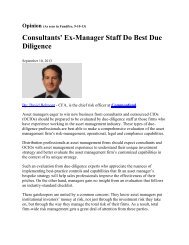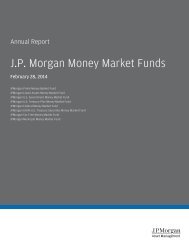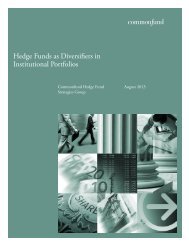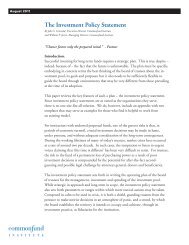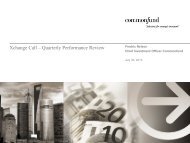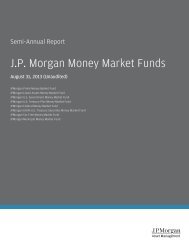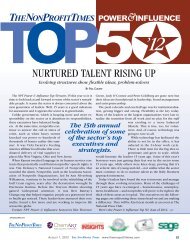Principles of Nonprofit Investment Management - Commonfund
Principles of Nonprofit Investment Management - Commonfund
Principles of Nonprofit Investment Management - Commonfund
Create successful ePaper yourself
Turn your PDF publications into a flip-book with our unique Google optimized e-Paper software.
Many such analytical tools are availableto institutional investors to aid themin making asset allocation decisions.Their utility, <strong>of</strong> course, varies. Thosemodels that use the concept <strong>of</strong> theefficient frontier must, by definition,assume the predictive validity <strong>of</strong> historicdata. But it’s axiomatic that pastperformance does not necessarily predictfuture results. Economic andfinancial events <strong>of</strong>ten swing far outside<strong>of</strong> past ranges, and the ranges are notalways reflected clearly in the averages(e.g., the average temperature <strong>of</strong> a mansitting on a cake <strong>of</strong> ice with his feet ina stove).The allocation planning model usedat <strong>Commonfund</strong> factors in manydifferent economic scenarios to projecta very wide range <strong>of</strong> possible outcomesfor any given asset allocation. In acomplex statistical process, the modeluses “Monte Carlo simulation” torandomly generate a thousand differentyield curves for next year and thenprojects how each <strong>of</strong> these is likely toaffect the results <strong>of</strong> each <strong>of</strong> nineteenasset classes.For each <strong>of</strong> the thousand scenarios,the model then generates anotherthousand yield curves for the secondyear and again projects the probableresults for those nineteen asset classes.The model runs these simulations foreach <strong>of</strong> twenty years into the future.Having processed so many differentpossible values for each variable, themodel’s output will show not just amean outcome but also a distribution<strong>of</strong> possible outcomes for each projectedinvestment period and the probability<strong>of</strong> each <strong>of</strong> those outcomes. Thisapproach, as you can see, goes beyondhistorically based averages and looksat what economic and financialconditions might really turn out tobe down the road. It also allows forthe examination <strong>of</strong> risk in the tails<strong>of</strong> potential outcomes beyond onestandard deviation.As a further guide for their decisionmaking, investors are also advised totake a hard look at the present environment,consider what the economic andmarket outlook might be for the nextfew years and what that suggests forinvestment strategy.No matter how sophisticated theplanning tools employed, the futureis unknowable. Ultimately, it comesdown to human judgments aboutwhat could happen, based on the bestinformation available at the time.Sometimes basic questions can tip thebalance. For example, in an environment<strong>of</strong> rising interest rates, shouldn’tyou be underweighting your bondallocation? When the returns <strong>of</strong> thebroad indexes are expected to becomparatively modest, shouldn’t yoube giving greater emphasis to skillfulstock picking and opportunistic tacticsto help achieve the returns needed tocover payout and inflation rates?- 18 -



